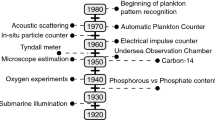Abstract
Plankton form the base of the food chain in the ocean and are fundamental to marine ecosystem dynamics. The rapid mapping of plankton abundance together with taxonomic and size composition is very important for ocean environmental research, but difficult or impossible to accomplish using traditional techniques. In this paper, we present a new pattern recognition system to classify large numbers of plankton images detected in real time by the Video Plankton Recorder (VPR), a towed underwater video microscope system. The difficulty of such classification is compounded because: 1) underwater images are typically very noisy, 2) many plankton objects are in partial occlusion, 3) the objects are deformable and 4) images are projection variant, i.e., the images are video records of three-dimensional objects in arbitrary positions and orientations. Our approach combines traditional invariant moment features and Fourier boundary descriptors with gray-scale morphological granulometries to form a feature vector capturing both shape and texture information of plankton images. With an improved learning vector quantization network classifier, we achieve 95% classification accuracy on six plankton taxa taken from nearly 2,000 images. This result is comparable with what a trained biologist can achieve by using conventional manual techniques, making possible for the first time a fully automated, at sea-approach to real-time mapping of plankton populations.
Similar content being viewed by others
References
Davis, C. S. (1982). Processes Controlling Zooplankton Abundance on Georges Bank. Ph. D. Thesis, Boston University.
Davis, C. S., Gallager, S. M., Berman, N. S., Haury, L. R. & Strickler, J. R. (1992). The Video Plankton Recorder (VPR): Design and Initial Results. Arch. Hydrobiol. Beith. 36: 67–81.
Davis, C. S., Gallager, S. M. & Solow, A. R. (1992). Microaggregations of Oceanic Plankton Observed by Towed Video Microscopy. Science 257 (10 July): 230–232.
Davis, C. S., Gallager, S. M., Marra, M. & Stewart, W. K. (1996). Rapid Visualization of Plankton Abundance and Taxonomic Composition Using the Video Plankton Recorder. DeepSea Research II, Vol. 43, No.7–8, pp. 1947–1970.
Fukunaga, K. (1972). Introduction to Statistical Pattern Recognition. Academic Press: New York.
Gonzalez, R. C. & Wintz, P. (1987). Digital Image Processing. Addison-Wesley.
Hu, M. K. (1962). Visual Pattern Recognition by Moment Invariants. IRE Trans. Information Theory IT8 (Feb.): 179–187.
Kauppinen, H., Seppanen, T. & Pietikainen, M. (1995). An Experimental Comparison of Autoregressive and Fourier-Based Descriptors in 2D Shape Classification. IEEE Trans. on Pattern Analysis and Mach. Intell. 17(2) (Feb.): 201–207.
Kohonen, T. (1987). Self-Organization and Associative Memory, 2nd Edition. Springer-Verlag: Berlin.
Kohonen, T. (1990). The Self-Organizing Map. Proceedings of the IEEE 78(9) (Sept.): 1464–1480.
Maragos, P. (1989). Pattern Spectrum and Multiscale Shape Representation. IEEE Trans. on Pattern Analysis and Mach. Intell. 11(7) (July): 701–716.
Matheron, G. (1975). Random Sets and Integral Geometry. John Wiley and Sons: New York.
Owen, R. W. (1989). Microscale and Finescale Variations of Small Plankton in Coastal and Pelagic Environments. Journal of Marine Research 47: 197–240.
Paffenhofer, G. A., Stewart, T. B. Youngbluth, M. J. & Bailey, T. G. (1991). High-Resolution Vertical Profiles of Pelagic Tunicates. Journal of Plankton Research 13(5): 971–981.
Persoon, E. & Fu, K. S. (1977). Shape Discrimination Using Fourier Descriptors. IEEE Trans. on Sys., Man, and Cyber 7(3) (Mar.): 170–179.
Reeves, A. P., Prokop, R. J., Andrews, S. E. & Kuhl, F. P. (1988). Three-Dimensional Shape Analysis Using Moments and Fourier Descriptors. IEEE Trans. on Pattern Analysis and Mach. Intell. 10(6) (Nov.): 937–943.
Reiss, T. H. (1991). The Revised Fundamental Theorem of Moment Invariants. IEEE Trans. on Pattern Analysis and Mach. Intell. 13(8) (Aug.): 830–834.
Reti, T. & Czinege, I. (1989). Shape Characterization of Particles via Generalized Fourier Analysis. Journal of Microscopy 156(Pt. 1) (Oct.): 15–32.
Schmitt, M. & Mattioli, J. (1991). Shape Recognition Combining Mathematical Morphology and Neural Networks. SPIE: Application of Artificial Neural Network. Orlando, Florida (April).
Serra, J. (1982). Image Analysis and Mathematical Morphology. Academic Press: London.
Tang, X. (1996). Transform Texture Classification. Ph. D. Thesis, Massachusetts Institute of Technology, the MIT/Woods Hole Oceanographic Institution Joint Program.
Teh, C. H. & Chin, R. T. (1991). On Image Analysis by the Methods of Moments. IEEE Trans. on Pattern Analysis and Mach. Intell. 10(4) (July): 496–513.
Vincent, L. (1994a). Fast Opening Functions and Morphological Granulometries. Proc. Image Algebra and Morphological Image Processing, SPIE 2300, 253–267. San Diego (July).
Vincent, L. (1994b). Fast Grayscale Granulometry Algorithms. EURASIP Workshop ISMM' 94, Mathematical Morphology and Its Applications to Image Processing, 265–272. France (Sept.).
Zahn, C. & Roskies, R. Z. (1972). Fourier Descriptors for Plane Closed Curves. IEEE Trans. on Computers 21(3) (Mar.): 269–281.
Author information
Authors and Affiliations
Rights and permissions
About this article
Cite this article
Tang, X., Stewart, W.K., Huang, H. et al. Automatic Plankton Image Recognition. Artificial Intelligence Review 12, 177–199 (1998). https://doi.org/10.1023/A:1006517211724
Issue Date:
DOI: https://doi.org/10.1023/A:1006517211724




